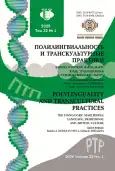Компаративные модели и образы в марийских народных песнях
- Авторы: Полякова Ю.В.1
-
Учреждения:
- Марийский государственный университет
- Выпуск: Том 22, № 1 (2025): ФИННО-УГОРСКИЙ НАРОД МАРИ: ЯЗЫК, ТРАДИЦИОННАЯ И ХУДОЖЕСТВЕННАЯ КУЛЬТУРА
- Страницы: 88-98
- Раздел: Лингвокультура
- URL: https://journal-vniispk.ru/2618-897X/article/view/326873
- DOI: https://doi.org/10.22363/2618-897X-2025-22-1-88-98
- EDN: https://elibrary.ru/GANNIC
- ID: 326873
Цитировать
Полный текст
Аннотация
Проведен анализ компаративных (структурных) моделей и компаративных образов (семантических особенностей) сравнений, функционирующих в марийских народных песнях. Структурными компаративными моделями в анализируемых текстах календарно-обрядовых и семейно-обрядовых песен являются следующие: «существительное в именительном падеже + послелог гае / гане / гай / гаяк»; «имя существительное в именительном падеже + имя существительное в именительном падеже»; «имя существительное в именительном падеже + послелог семын / семынак»; «имя существительное в именительном падеже + суффикс -ла ». В народных песнях наиболее продуктивны семантические компаративные модели, в которых человек или животное сравнивается с объектом окружающего мира (растительный объект: снеге пеледыш гае ӱдыр-таҥем кодеш ‘девушка-подруженька моя, как цветок земляники, остаётся’; зооморфный объект: шырчык гае латик уныкам уло ‘есть у меня одиннадцать внуков, подобных скворушкам’; природнo-религиозный объект: вӱташ петырыме шем ушкалет вӱд гыч лекше Вӱдава гае’ ‘чёрная корова в хлеву как Богиня-Мать воды, вышедшая из реки’; вещный объект: ‘ чевер мӱгинде гай ӱдыр-таҥна кодале ‘как пряник расписной, осталась наша душа-подруженька’). Сравнения носят символический характер, отражают народный взгляд на мир, демонстрируют проявление языкового творчества носителей диалектной речи. Некоторые сравнения из произведений марийского устного народного творчества стали символами, национально-специфическими стереотипами.
Ключевые слова
Об авторах
Юлия Владиславовна Полякова
Марийский государственный университет
Автор, ответственный за переписку.
Email: yulia_love95@mail.ru
ORCID iD: 0009-0000-5154-5674
аспирант кафедры финно-угорской и сравнительной филологии
Российская Федерация, 424000, г. Йошкар-Ола, пл. им Ленина, д. 1Список литературы
- Abukaeva, L.A. 2023. Mari guest songs in the context of hospitality traditions: a monograph. Yoshkar-Ola: Publishing House “Mari Book Publishing House.” Print. (In Russ.)
- Abukaeva, L.A., Chemyshev, A.V., and A.A. Mitruskova. 2019. Dictionary of comparisons of the Mari language. Yoshkar-Ola: Publishing house “Mari Book Publishing House.” Print. (In Russ.)
- Potebnya, A.A. 1926. Complete works, vol. 1. Kharkiv: State Publishing House of Ukraine. Print. (In Russ.)
- Priyatkina, A.F. 1997. “Dictionary entry ‘Comparative turnover’.” In Russian language. Encyclopedia. Moscow: Drofa. P. 197. Print. (In Russ.)
- Vinogradov, V.V. 1963. Stylistics. Poetics. Theory of poetic speech. Moscow: Prosveshchenie publ. Print. (In Russ.)
- Kuznets, M.D. 1960. Stylistics of the English language. Leningrad: Uchpedgiz publ. (In Russ.)
- Arutyunova, N.D. 1978. “Functional types of linguistic metaphor.” Izv. USSR Academy of Sciences, vol. 37, no. 4, pp. 28. EDN: YKCOPT Print. (In Russ.)
- Kazantseva, I.V. 2005. Functional and semantic field of comparativity in the Mari literary language: dissertation of Candidate of Philological Sciences. Yoshkar-Ola. EDN: NNODLP Print. (In Russ.)
- Kocheshkova, I.Y. 2004. Comparative tropes as a reflection of the author’s worldview in the work of J. Fowles. Abstract of the dissertation for the degree of Candidate of Philological Sciences. Barnaul. EDN: NNIYHJ Print. (In Russ.)
- Zamai, S.Y. 2008. “Functional and semantic category of comparativity and means of its representation in Russian and English.” Bulletin of the Adygea State University, no. 6, pp. 93–96. EDN: JENETO Print. (In Russ.)
Дополнительные файлы









